When I first attended the StrongFirst Bodyweight (SFB) Certification in 2016, I failed the one-arm pushup test that weekend. Having recently passed the SFG Level I Certification seven months prior, I was new to StrongFirst methods and strength training and still in the early stages of becoming strong.
Fast-forward to today, 2023, I have now passed the one-arm pushup (OAPU) test four times: at the SFB in 2016, 2019, and 2022, and at the SFL (to recertify my Elite status) in 2021.
Each time I train for the OAPU test, I learn more about this multifaceted movement that delivers so much more than just upper body strength. Practicing the OAPU not only yields tremendous symmetrical pushing strength, it’s also a full-body exercise that recruits and challenges the midsection, lats, glutes, quads, and even the hands and feet.
This article and training program represent the culmination of learnings from my coaches who helped me repeatedly achieve the OAPU over the years: the StrongFirst Certified Master Instructors Karen Smith, Andrea U-Shi Chang, and the StrongFirst Certified Senior Instructor Maggie Burrows. I hope this article helps you in your training in the same way that my coaches guided, encouraged, and supported me.
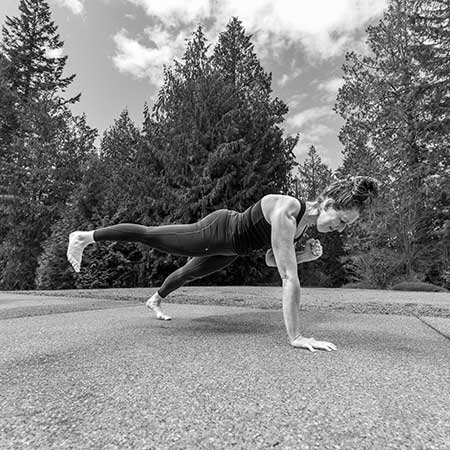
Before You Start
Before you start this program, test your OAPU with your hand on an elevation. Find an elevation where you can do one clean/strict rep without any compensations. Then, measure the height of that elevation.
It’s critical that you treat this as a skill practice and ensure your form is tight. Practicing poor quality reps where your plank falls apart, your shoulder shrugs, you rotate excessively, your feet cave in, and/or other problems arise will prevent you from achieving your OAPU and could even lead to injury.
For a list of common compensations in the OAPU, read this essential article by Karen Smith, StrongFirst Certified Master Instructor.
You’ll train four days per week for six weeks. Each week has one heavy day, two medium days, and one light day.
After you finish this six-week plan, retest your OAPU on an elevation. You’ll find that your strength has increased and that you can own a more challenging OAPU at a lower elevation—perhaps even an OAPU on the ground.
Prerequisite: If you can do five hardstyle two-arm pushups, you have what it takes to reap the benefits of this plan.
Pairs Well With…
Because the OAPU requires full-body tension and places a high tax on your central nervous system (CNS), it’s recommended that you do not do any other pressing during this plan. In general, you’ll want to avoid high CNS stress activities such as heavy deadlifts and heavy squats.
This plan can be combined with many other movements and training protocols, provided that the volume and rate of perceived exertion (RPE) are kept in the low to medium range. Specifically, OAPU training pairs well with:
- Kettlebell swings (one-arm and two-arm)
- Pulling movements such as pullups and rows
- Lower body work such as single leg work and squats (not too heavy)
- Kettlebell snatches
Do your OAPU practice at the beginning of each session when you’re fresh. If you’re doing additional training aside from the OAPU, make sure it’s made up of mostly light to medium effort days to give your CNS ample recovery.
You Will Train Four OAPU Progressions
Below are the four movements you’ll be practicing, as well as the training plan itself.
- Day 1—Medium: OAPU elevated on a barbell in the rack
-
- Number of reps: 5 per side
- Number of sets: 4 to 5 sets, depending on the week (see the program below)
- RPE: 6 out of 10
Why practice elevated OAPUs?
The elevated OAPU allows you to practice the OAPU without any added stability or assistance from the free hand. With this progression, you can feel the sensation of moving your bodyweight with only one arm. You can also choose and practice your preferred position for the free hand.
As you get stronger, you’ll need to lower the elevation of the barbell once every 1-3 weeks to keep the RPE at 6.
- Day 2—Heavy: OAPU with band-in-hand assist
-
- Number of reps: 2 per side
- Number of sets: 3 to 6 sets, depending on the week (see the program below)
- RPE: 8 out of 10
Why practice band-in-hand assisted OAPUs?
The band-in-hand assisted OAPU on the ground allows you to practice OAPUs with the same body positioning that you would use in an unassisted OAPU. You are mimicking the movement of a true OAPU. Adding assistance with a band in the free hand is less stable than assisting with the free hand on the floor; thus, it requires more cross-body midsection engagement and stability work.
Gripping the band tightly in the free hand encourages you to use irradiation, which will make your OAPU stronger.
Credit goes to Maggie Burrows, StrongFirst Certified Senior Instructor, for teaching me this OAPU progression!
- Day 3—Medium: OAPU with free hand assist
-
- Number of reps: Ladder: 1, 2, 3 per side
- Number of sets: 2-4 ladders, depending on the week (see program below)
- RPE: 7 out of 10
Why practice hand-assisted OAPUs?
Assisting with the free hand allows you to add as much or as little assistance as you want. A five-finger “tent hand” assist makes a rep much easier than a two-finger or one-finger assist. You can quickly customize the difficulty of each rep, dialing it up to an RPE of 9, or down to an RPE of 5.
This progression is more stable than the band-in-hand assist. The increased stability allows for a smoother movement and an increased focus on pure pushing strength. The free hand assist also lets you adjust the tempo and practice slower reps.
- Day 4—Light: One-arm/one-leg plank
-
- Number of reps: 10-15sec hold per side
- Number of sets: 3
- RPE: 5 out of 10
Why practice the one-arm/one-leg (OAOL) plank?
The OAOL plank builds stability and confidence in your setup for the OAPU. It forges a bulletproof midsection and a truly connected full-body plank.
It also allows you to practice key aspects of the OAPU with minimal taxation on your CNS.
The Training Plan
Here is the training plan you’ll follow. Be sure to take a rest day between the medium and heavy days.
Start with a full-body warm-up of your choice, making sure to include wrist and shoulder mobility work. I like to warm up by doing the Ground Force Exploration from Ground Force Method, followed by a Flexible Steel series that includes the kettlebell arm bar, halo, pump stretch, and Egyptian.
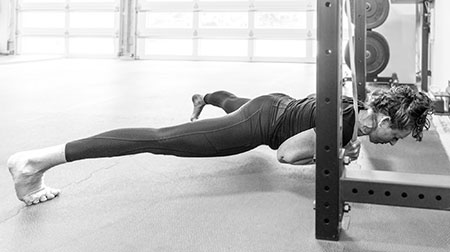
Final Thoughts
Video yourself so you can spot compensations and always optimize for quality. Working with an SFB StrongFirst Certified Instructor will help you avoid common pitfalls and progress more quickly.
This plan can also be used to train the one-arm/one-leg pushup (OAOLPU). Simply practice the band-assisted (day 2) and the hand-assisted (day 3) reps with one foot off the ground.
Whether you’re training the OAPU to prepare for the SFB Certification, or you’re simply a strength enthusiast who loves a new challenge, this plan will get you closer to your OAPU goals.
StrongFirst Bodyweight Fundamentals
In case civilization is temporary®

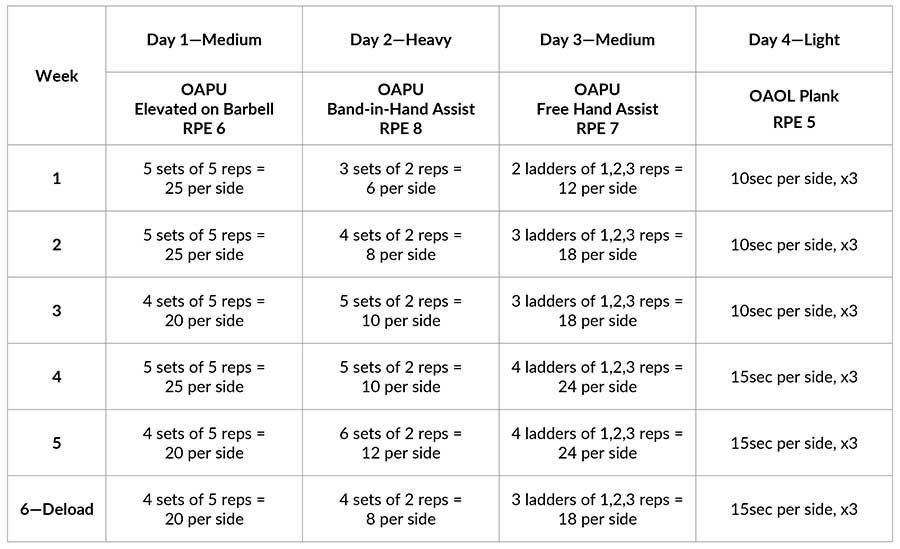
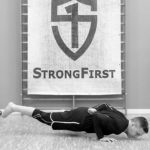
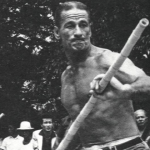
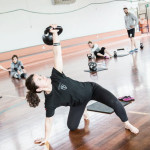
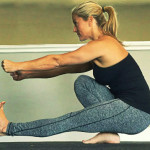

Thank you for the article and program.
I have nowhere to do the elevated push-up. Should I do instead two medium free hand assist push-up sessions a week?
Hi Andrus, Yes, that’s a good idea!
On Day 1 (Medium Day), do free-hand assist OAPUs on the floor. Do the number of reps listed in the program (either 5×5 or 5×4, depending on the week).
Since Day 1 (Medium Day) should be an RPE of 6, assist with 5 fingers on the free hand.
On Day 3 (Medium Day), the RPE is 7, and the reps are lower (ladders of 1,2,3), so you’ll want to assist with fewer fingers on the free hand, if possible. i.e. Assist with 4, 3, 2 fingers, or even 1 finger (depending on your current OAPU strength) on Day 3.
I’m excited to hear how your training goes! Thank you for reading the article. I hope it helps!
All the best and keep up the strong work!
Cat